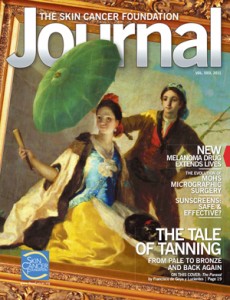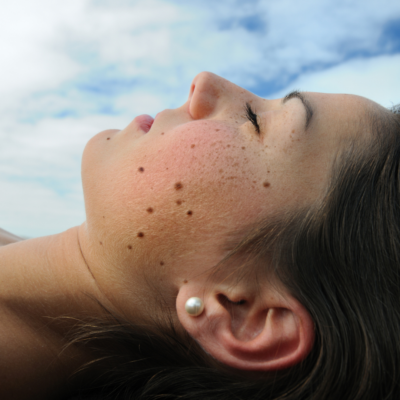Sun Hazards In Your Car
By Dr. Susan Butler, Published in The Skin Cancer Foundation Journal
 When thinking about sun exposure, you might envision yourself on the beach or exercising outdoors. But millions of Americans receive a large portion of their sun exposure when they don’t even realize it – in their cars.
When thinking about sun exposure, you might envision yourself on the beach or exercising outdoors. But millions of Americans receive a large portion of their sun exposure when they don’t even realize it – in their cars.
For years, dermatologists have observed that patients in the US often have more sun damage (which can lead to wrinkles, leathering, sagging, brown “age” spots and even skin cancers) on the left side of their faces than on the right. Why? Research increasingly points to ultraviolet A (UVA) radiation penetrating through car windows.
UV radiation from the sun, associated with about 90 percent of all skin cancers, reaches the earth as long wavelength UVA and shortwave UVB rays. Glass effectively blocks UVB, and windshields are specially treated to block UVA as well, but a car’s side and rear windows allow UVA to penetrate. UV exposure is cumulative, and research has proven that skin exposed to sun shining through window glass, even in the office, can over time lead to significant skin damage. The UV exposure we receive driving a car especially adds up. In a US study by Singer, et al, the researchers found asymmetric photodamage (sun-induced skin damage) on the face, with more brown pigment (color) and deeper wrinkles on the left. The more time subjects spent driving a vehicle, the more severe their photodamage on the left side. Reinforcing this research, in countries where the driver’s side is the right side, people tend to develop more sun damage and skin precancers on the right. Certain precancers can turn into squamous cell carcinoma, the second most common form of skin cancer.
Gender Differences
Recently, a study by Butler and Fosko showed that the majority of skin cancers in the US develop on the left side of people’s bodies and faces. This finding is especially pronounced in men, who more consistently spend time driving cars over a lifetime. While younger women have more left-side than right-side skin cancers, at age 50 this trend in them reverses, and right side skin cancers predominate until age 80. Though we can only speculate, the shift seen around age 50 may indicate that younger women spend more time as car drivers, receiving more exposure on the left side of their bodies, while older women may more often be passengers, thus sustaining more right-side sun damage. However, the number of vehicles per household has nearly doubled in the last 25 years, making it more likely that women today will spend more time as drivers rather than passengers.
Risk of Melanoma
Previous observational studies have shown an increased risk of melanoma in patients receiving large doses of UVA from tanning beds. Butler, et al also found that melanomas in situ (early, noninvasive melanomas that have not spread from their original tumor sites) were more common on the more UVA-exposed left side of the body. Our observations suggest that UVA exposure over the years may indeed play an important role in the development of this potentially dangerous skin cancer. (Melanoma is linked with intense, intermittent UV exposure; its association with cumulative UV exposure has been unclear.) In the US, the left side of the head, neck, arm and hand receive up to six times the dose of UV radiation as the right side in those sitting on the left side of the car. Convertibles and sunroofs allow even more UV exposure, so extra attention to sun protection must be paid if this type of car is driven.
Protecting Yourself
There are several ways to protect yourself in a car. The first is to apply a broad-spectrum sunscreen with an SPF (sun protection factor) of 15 or higher to your face, arms, neck and hands, about half an hour before you go driving.* [The Skin Cancer Foundation recommends using about an ounce over the entire body, including a teaspoonful on the face.] Because UVA passes through the window glass, make sure your sunscreen contains some combination of UVA-shielding ingredients such as zinc oxide, titanium dioxide, stabilized avobenzone, and ecamsule (MexorylTM).* Be sure to reapply after two hours, or after sweating heavily.*
Protective clothing, such as long sleeve shirts, long pants, UV-blocking sunglasses, and hats with a brim of at least 3 inches all around also help shield against the sun’s radiation.* Hats are particularly important for men who have thinning hair and are at risk for developing skin cancer on top of their heads.*
Another sun safety strategy in the car is tinting or laminating (applying UV-protective film to) the window glass.* Window tinting is regulated in many states, so be sure to check the laws, but clear window film is available throughout the country.* One study noted a 93 percent reduction in skin cell death when UV exposure was filtered through UV-absorbing auto glass. Some films, when applied to car windows, can block 99.9 percent of UV rays.*
Following all these precautions will help you stay sun-safe both on the road and once you reach your destination.*
Dr. Butler is a dermatologist and fellowship-trained Mohs micrographic surgeon. She is in private practice at the California Skin Institute in San Mateo, CA. Schedule an appointment with Dr. Butler or learn more about her.
*Individual results may vary and are not guaranteed.



 / 291 Reviews
/ 291 Reviews